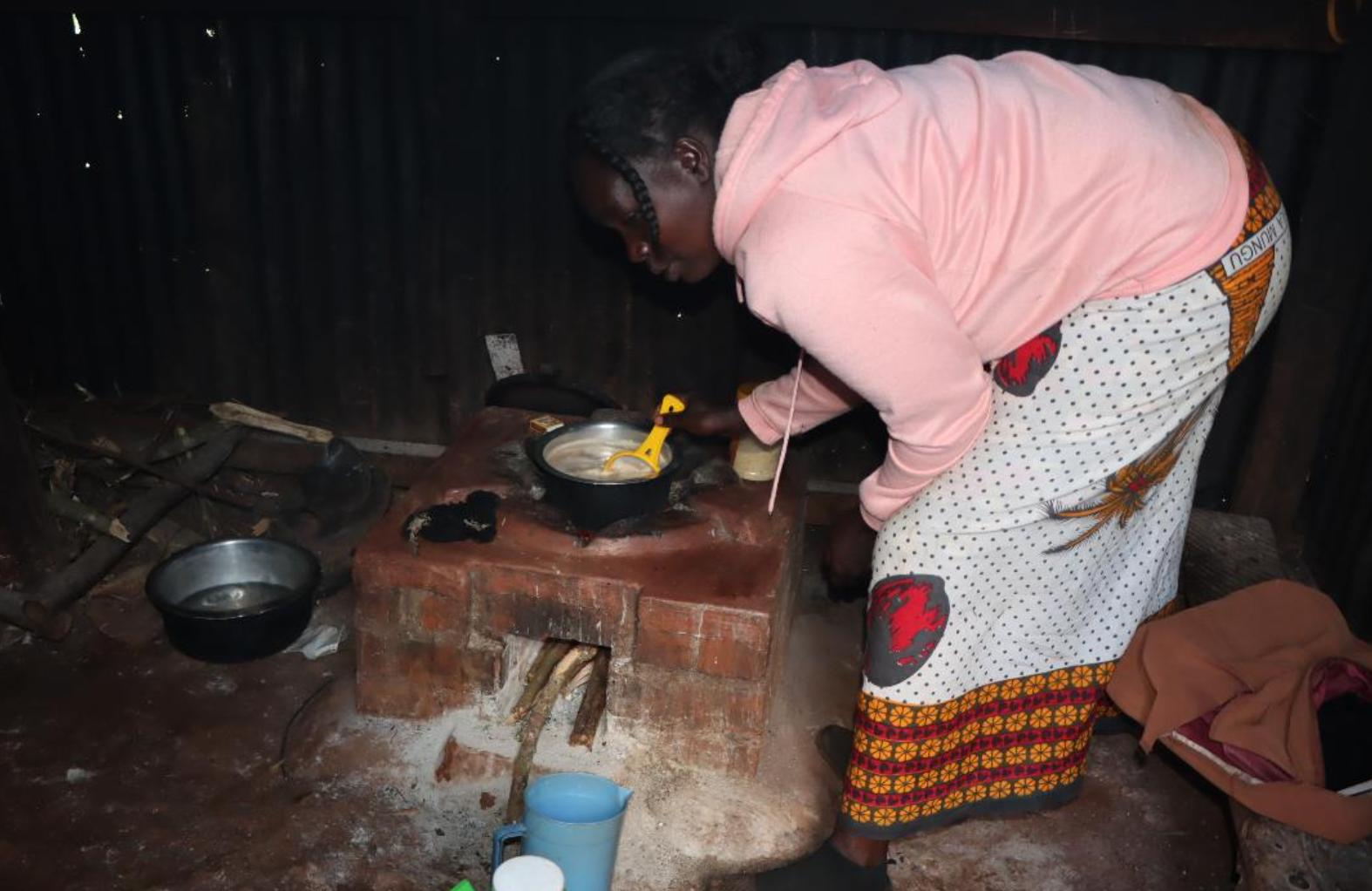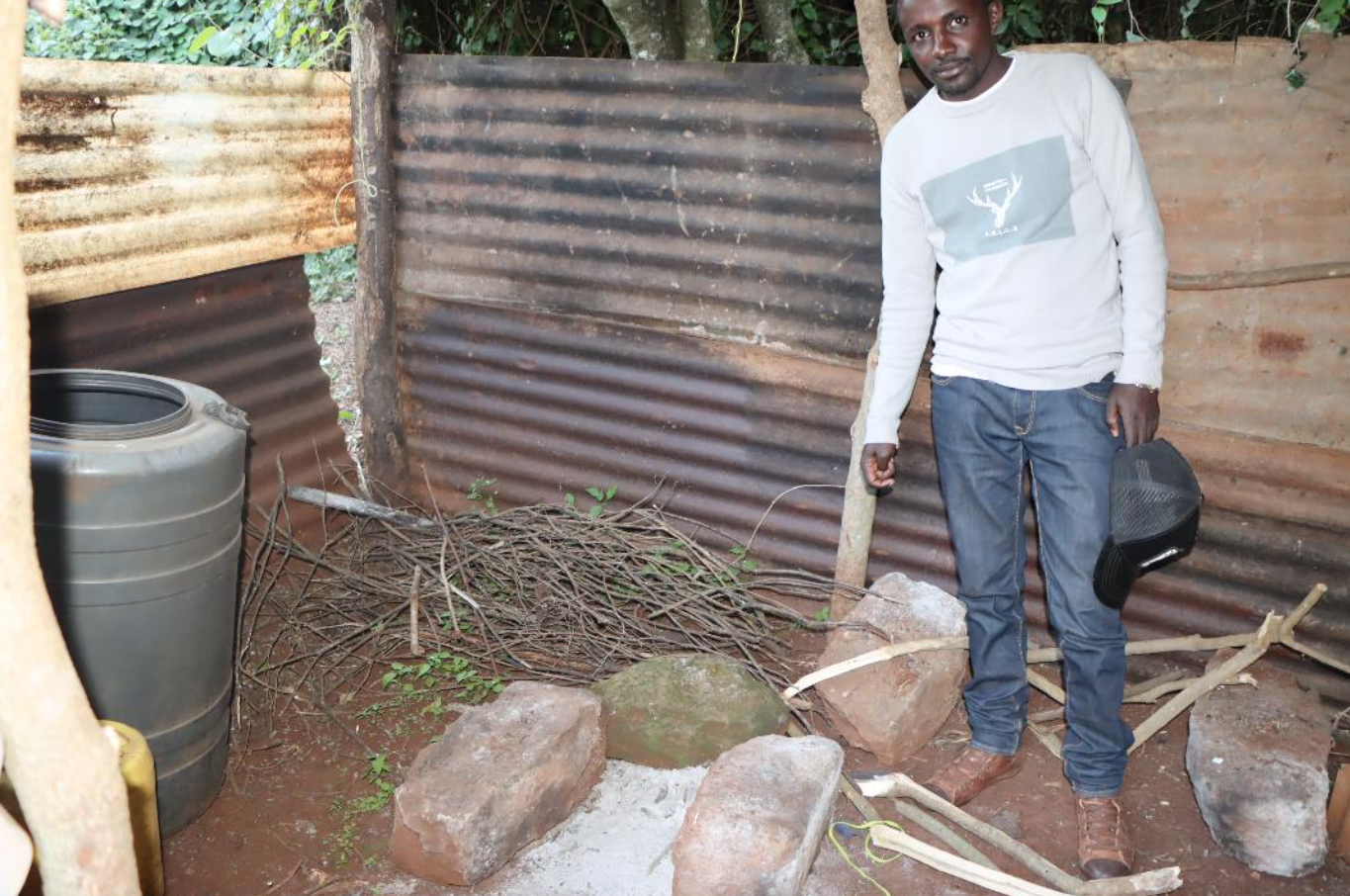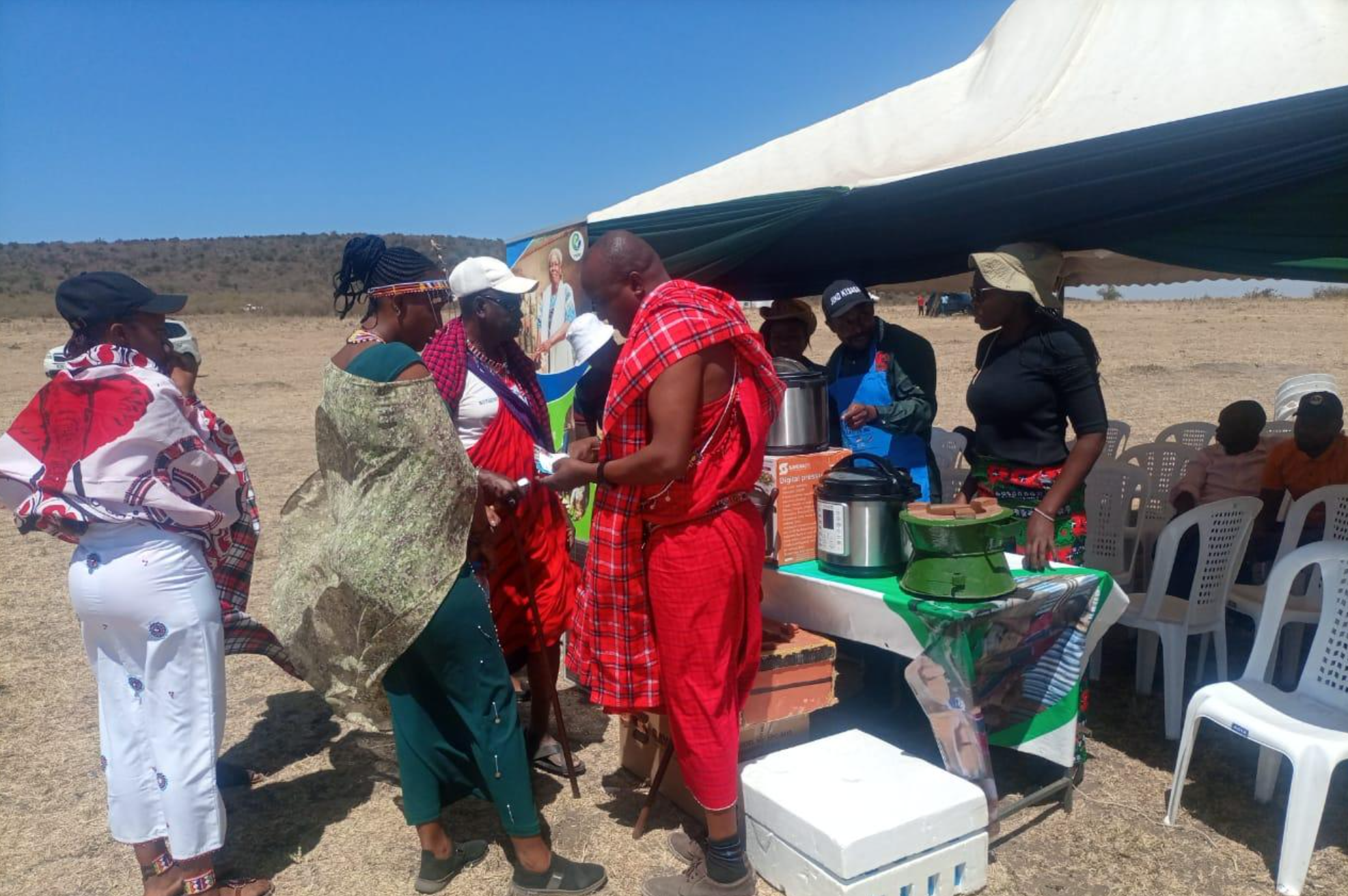 Mary Naserian in her kitchen, where she uses an improved cookstove.
Mary Naserian in her kitchen, where she uses an improved cookstove.
The morning light filters into Alice Siamanta’s home in Nalepo, Kajiado County, on the outskirts of Nairobi. Her kitchen walls are cleaner, her pots shine, and they have no soot. Her children are busy doing their homework, seated near her. The house is silent, with only the sound of books; there is no coughing. Alice cooks on a clean cookstove purchased through her savings in a women’s savings group.
“I never believed cooking could be this easy,” she says, smiling while lifting a pot of simmering beans. “No more tears in my eyes, no black smoke.”
In a neighboring tin-roofed home in Nalepo, 36-year-old Mary Naserian crouches over a three-stone fire. Smoke curls around her, stinging her eyes as she fans the flames beneath a pot of maize and beans. The acrid haze clings to her hair, her clothes, and her lungs. “My mother cooked like this, my grandmother too,” she says. “We never thought the smoke could kill us.”
Mary’s story reflects the struggle of millions of Kenyan households still trapped in smoky kitchens where poverty and tradition keep families tied to firewood and smoky kitchens. It is survival, keeping their tradition and community. But it comes at a cost: the hidden danger of household air pollution is a silent, daily assault on their health.
Indoor air pollution is a global killer. It is one of the world’s least discussed but deadliest health risks. According to the World Health Organization (WHO), it causes 3.2 million premature deaths every year, mainly from pneumonia, chronic obstructive pulmonary disease (COPD), heart disease, and lung cancer.
In Kenya, research based on the Global Burden of Disease (GBD) study, cited in the State of Global Air Report, estimates that around 23,000 people die annually from household air pollution, making it the eighth leading cause of premature death nationally.
This is more than outdoor air pollution. The youngest are most vulnerable: pneumonia remains the leading killer of children under five.
The culprit is familiar: household use of solid fuels such as wood, charcoal, dung, and crop residues, burned in open fires or inefficient stoves. In Kenya, about 70% of households still cook with these fuels, according to the Ministry of Energy.
In rural and peri-urban communities like Kibiko and Nalepo, kitchens are often poorly ventilated. The smoke levels inside can reach ten times higher than the WHO’s recommended safe limits for fine particulate matter (PM2.5).
 The old, inefficient three-stone fireplace.
The old, inefficient three-stone fireplace.
Kajiado County records respiratory diseases as among the top outpatient cases, according to the Ministry of Health’s Kenya Health Sector Strategic and Investment Plan (KHSSP) Mid-Term Review Statistical Report.
Kenya Medical Research Institute (Kemri) scientists have linked prolonged smoke exposure to heightened risks of acute respiratory infections in children and chronic respiratory disease in adults.
Wesley Mochama, a nurse at Oletepes Health Centre, sees the toll daily. He says, “Children come in with persistent coughs and wheezing. Mothers suffer from headaches and burning eyes. Almost every time, the root cause is the same - smoky kitchens.”
Indoor air pollution is not an equal-opportunity killer. Women and children bear the heaviest burden. Women like Mary spend long hours each day tending fires in kitchens that double as smoke chambers. Children, often strapped to their mothers’ backs or playing nearby, breathe in the same toxic air.
Studies show children under five are at the highest risk of pneumonia from indoor smoke. The economic burden is also gendered. Women lose time collecting fuel, and families spend money on hospital visits that could have been prevented.
The energy poverty trapping women in smoky kitchens also perpetuates cycles of poor health, missed school days for children, and lost productivity for families. This is according to Elijah Songok, the Director General of Kemri.
Despite the risks, a slow transformation is underway in Nalepo and Kibiko. A handful of households have shifted from three-stone fires to improved clean cooking stoves, a simple innovation that burn fuel more efficiently and produces far less smoke.
The difference is visible: kitchens once blackened by soot now have clearer walls, mothers no longer cook with streaming eyes, and children cough less. Families are also saving money on firewood. Yet adoption remains stubbornly low.
A 2022 GIZ survey found that while 82 per cent of households in Kajiado had heard about improved stoves, only 23 per cent were using them regularly.
The barriers are complex and include affordability, durability concerns, and cultural habits. For stable foods like ugali and githeri, some believe only a three-stone fire achieves the right taste and consistency.
For Mary, affordability was the barrier: “If I could get one on credit, I’d try. But paying at once is impossible.”
Her turning point came when she joined the Naserian Women Group, which partners with GIZ Kenya and the Clean Cooking Alliance. Through a pay-as-you-go model, she acquired her first improved stove for Sh2,500, paid in installments.
“It felt strange at first,” she says, “but my eyes don’t sting anymore, and my children stopped coughing. I use half the firewood now.”
The crisis of indoor air pollution is preventable. Solutions already exist, and some are proving effective.
According to experts
from the Ministry of Energy and GIZ Kenya, some of the proposed solutions
include Subsidies and Microfinance, facilitated through Saccos and women’s
groups. These affordable financing options can make stoves accessible through
pay-as-you-go models, loans, or community savings groups.
 The Nalepo women group is now helping women access improved cookstoves.
The Nalepo women group is now helping women access improved cookstoves.
In Kenya,
tackling indoor air pollution aligns with national health goals, environmental
sustainability, and gender equity. For the world, it contributes to climate
commitments and the Sustainable Development Goals. It is also a question of
justice.
Why should
women like Mary Naserian pay with their lungs to put food on the table?
Back in
Nalepo, Mary reflects: “The smoke has always been part of our lives. But maybe
it doesn’t have to be.”
Mary lifts
her pot off the fire, eyes watering. A neighbour tells her about her new stove
and how her kitchen is now smoke-free. Mary dreams of the same relief. “The
smoke has always been part of our lives,” she says softly. “But maybe it
doesn’t have to be.”
Alice’s
children, doing homework beside her smoke-free stove, represent a brighter
future. The battle against household air pollution is about more than clean
kitchens. It’s about health, dignity, gender equality, and climate resilience.
The neighbour
shares her experience with an improved cookstove purchased through a local
women’s savings group. It was a basic model, a rocket stove, priced at Sh2,500,
paid in three installments over three months.
“Her kitchen
has no black soot anymore,” Mary observes. “She said her firewood now lasts
twice as long.”
Encouraged,
Mary joined the Naserian Women Group, a community-based organization that
partners with GIZ Kenya and the Clean Cooking Alliance to distribute affordable
stoves and make briquettes from farm waste. Through a pay-as-you-go model, Mary
received her own improved stove within weeks.
“It felt
strange at first. But my eyes don’t sting anymore, and my children stopped
coughing at night,” she says. “I use half the firewood now — and spend less
time gathering it.”
The Kenya government
also has a goal to reach universal access to clean cooking by 2030, but
progress is slow, hampered by cost, infrastructure gaps, and cultural
resistance.
The government
is taking several paths to this goal.
Through the
Mwananchi Gas Project, low-income households are provided with free
six-kilogramme LPG cylinders and burners, and schools are also being
transitioned from firewood to LPG, reducing deforestation and protecting
health.
The government’s
Last Mile Connectivity Project (LMCP III), backed by the African Development Bank, is also
delivering over 150,000 new rural electricity
connections in 45 counties.
Within it,
the Kenya Electric Cooking Market Development Initiative (KEMDI) aims to expand eCooking from 49,000 to 500,000
users in three years, subsidizing
electric pressure cookers and induction stoves. Kenya Power is piloting 47,000 subsidized
cookers in Kiambu,
Machakos, and Kajiado — cutting household reliance on biomass.
By linking
electrification to clean cooking, Kenya is ensuring that power lines mean
healthier kitchens, not just lightbulbs.
GIZ Kenya is also a
central player in the country’s clean cooking transition, aligning its work
with the Kenya National Cooking
Transition Strategy (KNCTS), which targets universal access by 2028.
Beyond simply distributing stoves, GIZ is strengthening the ecosystem needed to
sustain long-term adoption.
Venice Makori
of GIZ Kenya explains: “We are not only distributing stoves but building a
clean cooking sector — strengthening supply chains, financing, and awareness.
Clean cooking is about dignity, climate resilience, and creating jobs.”
GIZ has flagged
off last-mile entrepreneurship projects, training women and youth to become
clean energy champions and distributors in their villages. These initiatives
are supported by innovative financing tools such as results-based financing
(RBF), carbon credit schemes, and partnerships with county governments.
Ezekiel Moseri, a clean
cooking expert at GIZ, emphasises the importance of entrepreneurship at the
grassroots:
“Last-mile
entrepreneurs are the backbone of the clean cooking transition. They are the
ones who reach the villages, explain how the stoves work, and build trust with
households. Without them, even the best technology will remain in shops in
Nairobi. We are investing in women and youth at the community level, helping
them become distributors and technicians, so that clean stoves are not just
available, but truly accessible.”
At the policy level, GIZ provides technical advice to the Ministry of Energy and supports Kenya’s participation in global climate initiatives. “Clean cooking is not just about health—it’s about livelihoods, dignity, and climate resilience,” Moseri says.
Kenya isn’t
alone in tackling smoky kitchens. In Ethiopia, a World Bank–backed programme
has supplied improved stoves to more than 10 million households.
Rwanda
integrates clean cooking into its climate adaptation financing, linking
every stoke to carbon accountability. Meanwhile, India’s Ujjwala Scheme
distributed free LPG connections to over 80 million rural households—though
many still struggle to afford refill costs.
GIZ is also
on the ground here. Through its EnDev program, the agency has issued calls
Kenya can
draw lessons from these models—particularly in pairing hardware delivery with
financing and sustained behaviour change campaigns.
Kenya’s path to clean cooking must be multi-layered: stronger political will, better financing options, public-private partnerships, and grassroots innovation. Local women’s groups like Naserian are already leading the way—making fuel briquettes, demonstrating clean stoves, and organising group purchases.
Roisa Kerry is a public health practitioner











